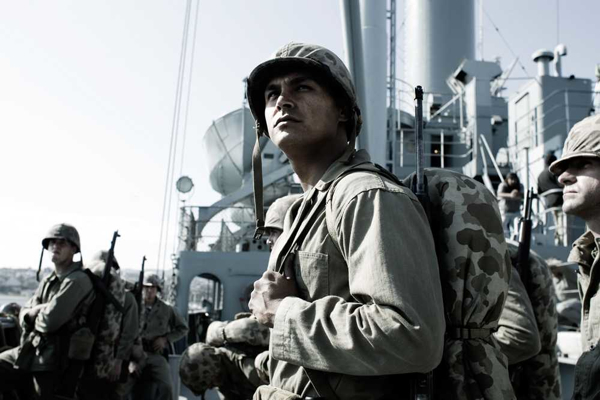Movie review by Greg Carlson
A visually arresting exploration of the legend behind AP photographer Joe Rosenthal’s iconic World War II image of the Mount Suribachi flag raising, “Flags of Our Fathers” considers a range of ideas about heroism, propaganda, and the life of the soldier. Director Clint Eastwood, continuing to capitalize on the public and critical perception of his mature career gravitas, crafts an impressive drama, particularly in the story thread that considers the life of Ira Hayes (Adam Beach, in the movie’s best performance), one of the Marines who appeared in the fateful snapshot.
Fans of the combat film will no doubt identify striking similarities to co-producer Steven Spielberg’s own “Saving Private Ryan,” which employed the same style of desaturated imagery, especially during the battle sequences. Both movies attempt to honor the sacrifices of the “citizen soldiers” who served during World War II, while still taking the time to ruminate on the surreal absurdity and haphazard nature of killing for one’s country. Eastwood approaches the story elements out of chronological order, carefully and purposefully striking a balance between the events of Iwo Jima and the manner in which the United States government raised substantial sums of money trading on Rosenthal’s powerful photo.
One strength of “Flags of Our Fathers” lies in the careful explanation of the circumstances surrounding the origin of the photograph itself, which has fascinated generations of people who read about and study World War II. Because faces were not visible in the image, a certain amount of confusion surrounded the identification process. Only three of the pictured men survived the fighting, and an earlier planting of a smaller flag on essentially the same spot added to the commotion when sorting out details became a priority. Claims that the picture was staged, as well as the misidentification of one of the flag raisers, didn’t help either.
Along with Hayes, survivors John “Doc” Bradley (Ryan Phillippe) and Rene Gagnon (Jesse Bradford) are called upon by military brass to make public appearances for war bonds. Each man deals with the attention in a different manner, with Bradley’s introspection contrasted with Gagnon’s more gung-ho attitude. Hayes, troubled by the idea that he should even be considered a hero, descends into alcoholism and deep depression. Additionally, Hayes deals on a regular basis with racist comments, and Beach is called upon to deal with the difficult task of portraying psychological pain.
Eastwood is certainly savvy to the ways in which events of well more than half a century ago apply to Americans today. “Flags of Our Fathers” will be joined by the director’s “Letters from Iwo Jima” next year, which will address the battle from the perspective of the Japanese. Certainly, “Flags of Our Fathers” can be addressed on its own, but the upcoming film will invite new readings and interpretations. If “Flags of Our Fathers” makes any missteps, it is in the unnecessary final summarizations that try to put into words thoughts better left expressed in visuals. Eastwood continues to show audiences that his career behind the camera can be every bit as compelling as the work he does in front of the lens.
